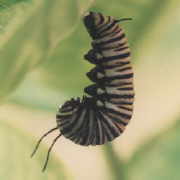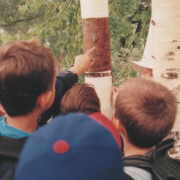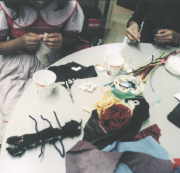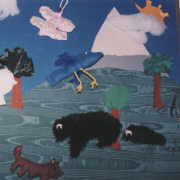|
||
 |
||
|
Debbie O'Rourke is a graduate of the Alberta College of Art who uses diverse media from drawing to sculpture and batik. O'Rourke's educational programs focus primarily on Grade 6 and under. Dwelling on the common ground between art and science, they help both teacher and student to see creativity as intrinsic to human thought and learning processes. For a schedule of fees and travelling programs, please email the artist. |
||
|---|---|---|
|
|
||
|
|
This slide presentation is based on the life cycle of the Monarch butterfly. The slides include close-ups taken of the Monarch in its various stages, plus photos of the artwork that grew from Debbie's observations. The all-ages presentation demonstrates how nature can be a teacher and inspiration, and how sensitive observation gives rise to creativity. |
|
|
|
||
|
|
In this exercise the student, like the naturalist, uses drawing and writing as tools to record and classify his or her world. The artist provides fascinating natural history materials, and works with the school to secure some live animal models. CAUTION: Students are not shown examples of scientific illustration, nor are they expected to make a replica. They love this exercise and with an experienced artist in the classroom, they are encouraged in a manner that is appropriate to their age. |
|
|
|
||
|
|
A short talk informs students how to conduct themselves to ensure maximum contact with wildlife. Then we go outside to count and draw the life-forms we find. Afterward, the class lists the animals and plants they saw. This is like the wildlife counts frequently carried out by scientists. Their sketches can later be used as references in the creation of artwork or as documents that the teacher can access for the science curriculum. It's a very inspiring exercise when a field trip gives the students a chance to record exciting fauna like swans, snakes and woodpeckers. But it can also be enlightening when carried out in a school yard. |
|
|
|
||
|
|
A field trip (see above) can be used as a source for a classroom project about the current and former animal occupants of the students' neighborhood. When this isn't possible, nature books and the artist's picture collection provide inspiration. Using donated waste materials and fabric leftovers, students sew their own stuffed animals. They enjoy learning a useful skill, as well as discovering the craft of designing their own creations from available materials. Before they take them home, they can be given the collaborative experience of creating an environment within which the animals can live together. (see below) |
|
|
|
||
|
|
On longer projects, the artist can continue working with the class to finish a permanent wall-hanging that includes all the students' creations. In most situations the stuffed animals are put together on a bulletin board as illustrated, on a tabletop or in a display case. While most students finish sewing their animals, the artist will work on the background with a crew of students who have completed their animals. Frequent meetings of the class will be called to get the group's input on composition and content. This process of team decision-making mirrors the way that many artists make their living: contributing their talents to industry and the media. |
|
|
|
||
|
For TEACHERS: |
||
|
|
||
|
When I was fifteen, I could paint like
Raphael: |
||
|
Do no harm. -Hippocratic Oath. |
||
|
|
A very well-kept secret is the fact that children make
real art. To design is human, and children in the early
elementary years show a natural sense of composition and a
liveliness that is much envied and copied by trained artists
and illustrators. |
|
|
It is hard to help someone with their creativity, but easy to damage their confidence. O'Rourke works with teachers to help them understand how an artist and art critic sees and comments on children's work with the aim of fostering all the students. It is difficult to know, in a group of enthusiastic and imaginative primary students, who might become an artist later on. But a large fraction of any group of children are visual learners, and all of them benefit from the mental, physical and creative exertion of art-making. |
||
|
|
These programs were conceived and delivered by Debbie O'Rourke under the Artists in Education Program of the Ontario Arts Council. |
|
|
|
||
|
|
||
|
|
||
|
|
||
|
|
||
|
I've been discovering that my teaching approach is called place-based education. There are many important reasons why I feel it is important to share the natural world with children, without burdening them with the task of cleaning up our messes. To quote David Sobel: "Lurking beneath (some) environmentally correct curricula is the assumption that if children see the horrible things that are happening, then they too will be motivated to make a difference. But those images can have an insidious, nightmarish effect on young children whose sense of time, place, and self are still forming... What's important is that children have an opportunity to bond with the natural world, to learn to love it and feel comfortable in it, before being asked to heal its wounds... If we prematurely ask children to deal with problems of an adult world, we cut them off from the possible sources of their strength." The complete essay is available online, through the excellent Orion Online website. Click the address below to link to Sobel's essay: http://arts.envirolink.org/arts_and_education/DavidSobel1.html |
||
|
Don't forget to come back! |
||







 link
link


 links to great Monarch butterfly sites
links to great Monarch butterfly sites 